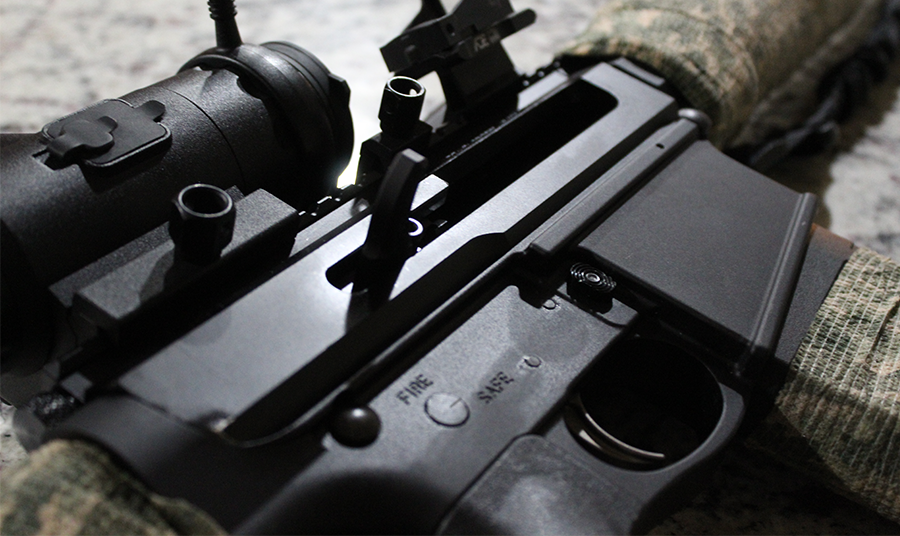Understanding how a rifle cycles and manages recoil can significantly influence your shooting experience by allowing you to choose which of the two most popular operating systems is best for you, namely the direct impingement and gas piston systems. Though both systems rely on gas generated from the fired cartridge to cycle the action, they do so in different ways, leading to unique effects on recoil, maintenance, and overall performance.
What Is Direct Impingement?
Direct impingement is most famously associated with the AR-15 platform. This system works by diverting a portion of the gas produced when a round is fired through a small port in the barrel. The gas travels through a gas tube and directly impacts the bolt carrier group (BCG), driving it rearward. This movement cycles the action by ejecting the spent casing, compressing the buffer spring, and then allowing the spring to push the BCG forward, chambering the next round.

Image credit: Edmund Huet via Creative Commons
How Direct Impingement Affects Recoil
One of the main benefits of direct impingement is its relatively smooth and manageable recoil. Since the gas directly impinges on the bolt carrier group without the need for additional moving parts, the recoil impulse is more linear and less jarring. This results in minimal muzzle rise, making it easier to stay on target for follow-up shots.
However, this system also brings hot, dirty gases into the action, leading to carbon buildup. While this doesn’t directly affect recoil, it does mean more frequent cleaning is necessary to keep the rifle running smoothly.
The AR-15 is perhaps the most iconic rifle utilizing a direct impingement system. Known for its modularity, accuracy, and relatively soft recoil, the AR-15 is a favorite among sports shooters, hunters, and law enforcement.
What Is a Gas Piston System?
In a gas piston system, the gas produced by the fired round is also tapped from the barrel, but instead of traveling down a tube to directly impact the bolt carrier group, the gas drives a piston, which in turn pushes the bolt carrier group rearward. The key difference here is the separation of the gas from the action; the piston acts as an intermediary that transfers energy without introducing the gas into the receiver.

Image credit: Edmund Huet via Creative Commons
There are two types of gas piston systems: long-stroke and short-stroke. In a long-stroke system, the piston is attached to the bolt carrier group and moves with it throughout the cycle, as seen in the AK-47. In a short-stroke system, the piston moves independently, delivering a short impulse to the bolt carrier group before returning to its original position, as found in the HK416.
How Gas Pistons Affect Recoil
Gas piston systems tend to produce more felt recoil compared to direct impingement. This is because the piston adds extra mass and moving parts to the equation, resulting in a slightly more abrupt and less linear recoil impulse. However, the trade-off is that gas piston systems run cooler and cleaner because the dirty gases are vented away from the action, reducing the need for frequent cleaning.
Gas piston systems are often preferred in adverse conditions where reliability is paramount, such as in military or law enforcement scenarios.
The AK-47 is a classic example of a long-stroke gas piston system. Its legendary reliability, even in harsh conditions, is balanced by a noticeable but manageable recoil. The HK416, on the other hand, represents a modern short-stroke piston system, offering improved accuracy and less muzzle rise than the AK-47 while maintaining reliability.
Direct Impingement vs Gas Piston: A Side-by-Side Comparison
- Recoil: Direct impingement offers smoother, more linear recoil, while gas piston systems produce slightly more felt recoil due to the added mass of the piston.
- Maintenance: Direct impingement systems require more frequent cleaning due to carbon buildup in the action. Gas piston systems, with their cleaner operation, are easier to maintain over time, especially in dirty or wet environments.
- Reliability: While both systems can be highly reliable, gas piston systems have an edge in adverse conditions due to their ability to run cooler and cleaner.
Choosing between a direct impingement and a gas piston system comes down to your specific needs and preferences. If you prioritize a smoother shooting experience and don’t mind a bit of extra cleaning, direct impingement is a great choice, especially for target shooting or home defense. On the other hand, if you need a rifle that will run reliably in the harshest conditions with minimal maintenance, a gas piston system might be the better option.
Impact on Optics and Accuracy
When it comes to optics, the choice between direct impingement and gas piston systems can also play a role in how well your sights or scopes hold zero and perform over time. Direct impingement systems generally produce less overall movement and vibration since the gas directly impinges on the bolt carrier group, resulting in a smoother action. This smoother cycling can help maintain the stability of your optics, reducing the likelihood of your zero shifting over time, especially with precision optics.
On the other hand, gas piston systems introduce additional mass and movement through the piston, which can create more vibration and a sharper recoil impulse. This increased mechanical stress may cause a slight shift in zero or put more wear on the optic’s mounting system over extended periods of use. However, many modern optics and mounts are designed to withstand these forces, so the impact might be minimal. The cleaner operation of gas piston systems also means less debris and carbon buildup on the optics, which can be a concern with direct impingement systems where gases are vented into the action and potentially near the optic.
Both systems have their strengths and weaknesses, and understanding these can help you make an informed decision that enhances your shooting experience. Whether you’re on the range or in the field, knowing how your firearm operates will always give you an advantage.
Have a great outdoor adventure story? Share it with us! Accepted stories will receive a 20% discount code.
Frequently Asked Questions
What is direct impingement?
Direct impingement is a system commonly used in rifles like the AR-15, where gas from the fired round is directed through a gas tube to impact the bolt carrier group, cycling the action.
How does direct impingement affect recoil?
Direct impingement systems tend to have smoother and more manageable recoil due to the linear impulse from the gas directly impacting the bolt carrier group, resulting in minimal muzzle rise for easier follow-up shots.
What is a gas piston system?
A gas piston system is an operating system where gas from the fired round drives a piston, which then pushes the bolt carrier group rearward, separating the gas from the action to reduce carbon buildup.
How do gas piston systems affect recoil?
Gas piston systems typically produce more felt recoil compared to direct impingement systems because of the additional mass and moving parts of the piston, resulting in a slightly more abrupt and less linear recoil impulse.
What are the main differences between long-stroke and short-stroke gas piston systems?
In a long-stroke system, the piston is attached to the bolt carrier group and moves with it throughout the cycle, while in a short-stroke system, the piston moves independently and delivers a short impulse to the bolt carrier group before returning to its original position.




